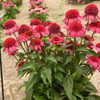Product Description
Echinacea 'Watermelon Sugar' PPAF (30)ct Flat
DOUBLE DIPPED™ Series
Common Name: Coneflower
Double pompom flowers open magenta pink before maturing to a medium pink. Flowers are produced over a large rosette of foliage with almost no exposed stem.
DOUBLE DIPPED™ Echinacea have large, fully double 4½" flowers with wide, overlapping ray petals. Each variety has substantial landscape size at 2-2½' tall, perfect for the middle of the border. Strong, well-branched stems support the large, numerous heavy flowers with ease. Mounded habit of dark green foliage. Best performance comes in full sun and well-drained soils.
Praised for their cheerful brightly colored flowers, coneflowers are a mainstay in today's garden. Be sure to leave some spent blooms on the plants in the fall because their seeds provide winter food for finches and other birds. The dried seed heads also provide architectural interest in the winter.
Coneflowers like it sunny and hot. Though they will tolerate light shade, fewer flowers will be produced, and the plants will be weakened. Light, loamy soils are best, but coneflowers will grow in any well-drained soil. Once established, they are quite drought tolerant. If properly cared for, they will form attractive colonies and will live for many years.
Height: 22.0-26.0 Inches
Spread: 20.0-24.0 Inches
Hardiness Zones: 4,5,6,7,8
Flower Color: Pink shades
Foliage Color: Green shades
Full Sun (> 6 hrs. Direct Sun) to Part Shade (4-6 hrs. Direct Sun)
Low to Average Water Needs
Poor to Fertile Soil Quality
Bloomtime: Midsummer to Late Summer
Deer Resistant
Seasonal Interest: Dried Seed Heads
Growth Rate: Medium
Border Plant, Container, Cut Flower, Dried Flower, Fragrant Flowers, Mass Planting
Echinacea 'Watermelon Sugar' is a delightful coneflower that adds a burst of vibrant color to the garden. Here is a breakdown of what makes it special:
What Makes Echinacea 'Watermelon Sugar' Special
- Vibrant Color: It boasts large, double flowers in a stunning shade of magenta pink that fades to a lighter pink as they mature, reminiscent of a ripe watermelon.
- Double Flowers: Unlike traditional coneflowers with single petals, 'Watermelon Sugar' has fully double, pom-pom-like flowers that are extra showy.
- Long Blooming Period: It blooms profusely from mid-summer to late summer, providing weeks of color.
- Compact Size: It is a relatively compact variety, making it suitable for smaller gardens and containers.
- Attracts Pollinators: Like other coneflowers, it attracts butterflies, bees, and other beneficial pollinators.
- Deer Resistant: It is generally avoided by deer, which is a bonus for gardeners in areas with deer pressure.
Description and Details
- Common Name: Watermelon Sugar Coneflower
- Botanical Name: Echinacea 'Watermelon Sugar'
- Mature Size: 22-26 inches tall, 20-24 inches wide
- Foliage: Green, lance-shaped leaves
- Flowers: Double, magenta pink flowers that fade to lighter pink, blooming from mid-summer to late summer
- Growth Habit: Upright, mounding
- Hardiness Zones: 4-8
- Light: Full sun to part sun
- Soil: Well-drained, adaptable to various soil types
- Water: Drought-tolerant once established
Landscaping Design Tips
- Middle of the Border: Its height makes it ideal for the middle of borders, where it can add a pop of color without overshadowing shorter plants.
- Container Gardening: It thrives in containers, making it a great choice for patios and balconies.
- Mass Plantings: Plant it in groups or masses for a more dramatic effect.
- Cottage Gardens: Its vibrant color and upright form make it a good fit for cottage gardens.
- Cut Flower Gardens: The long-lasting flowers are excellent for cutting and arranging.
- Companion Plants: Consider pairing it with other sun-loving perennials with contrasting colors and textures, such as:
- Salvia
- Yarrow (Achillea)
- Ornamental grasses
- Sedum
Planting and Care
- Planting:
- Choose a sunny location with well-drained soil.
- Plant in spring or fall.
- Space plants according to their mature size (about 20-24 inches apart).
- Water thoroughly after planting.
- Care:
- Water regularly until established, then only during prolonged dry spells.
- Fertilize lightly in spring if desired.
- Deadhead spent flowers to encourage more blooms.
- Cut back stems in late fall or early spring.
Additional Notes
- 'Watermelon Sugar' is part of the Double Dipped™ series of coneflowers, known for their large, double flowers and strong stems.
- It is a great choice for gardeners looking for a low-maintenance, deer-resistant perennial with long-lasting color.
- The seed heads that remain after the flowers fade provide winter interest and food for birds.
Thirty (30) plants per flat (or tray). Approximate Plug Measurements: 3 inches deep x 2 inches wide.
Other Details
The most important part of the plant is its root system. Healthy roots are the foundation of a healthy, vibrant plant. The type of plug container used is based on the specific needs of the plants. Perennials offered as bare root traditionally perform better when planted as bare root.Planted in a specialized mix, potted plants have well established root systems. Top growth stage will vary depending on the current life cycle and time of year when shipped. In Winter and early Spring dormant plants may be shipped. Dormant plants may be planted right away, even before the last frost date.
Most bare root varieties are field grown for at least one season, though Hemerocallis and Hosta are grown for two seasons. The bulk of the soil is removed during the harvesting process and the tops of most varieties are trimmed back to the crown. They are graded, packed in shredded aspen or sphagnum moss and stored in freezers until ready to be shipped.
See our Container Sizes and Bare Root Perennials pages for more information.
Plant information and care is provided in the Overview section, Plant Genus Page and general information is provided in the Planting Care & Guides. Additional questions can be asked on each Plant page.
Plant Spacing: Using the maximum mature spread or width of a plant to guide spacing, ensures space to grow to full size. To fill an area sooner, plant them closer together. Just remember, future thinning or transplanting may be needed.
Water: Keep a close eye on newly planted perennials, especially throughout the first growing year. Most early plant loss is due to too much or too little water!







